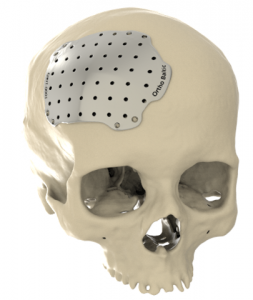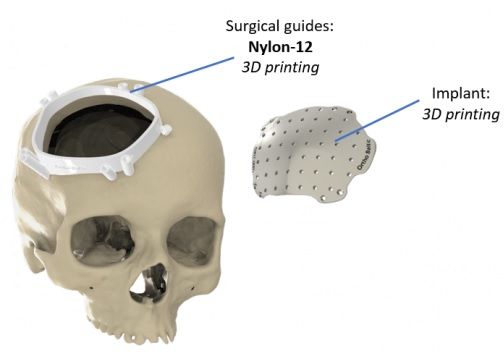Description
Patient-specific cranial implants are plate-type medical devices that differ by their size and configurations (depending on the size and location of the cranial defect) and that are used in cranioplasty to correct cranial defects. The main goals of cranioplasty are to prevent injuries and infection of the unprotected brain, to correct cranial deformations and restore the aesthetic of the skull.
Nowadays in cranioplasty, the following ways are mainly used to fill cranial defects: bone grafts, mesh, standard cranial implants, patient-specific cranial implants, and quick-hardening polymeric substances (PMMA). The latter way is relatively cheap; however, when using PMMA, the implant is formed directly on the soft tissues that cover the cerebral cortex, even though this quick-hardening material emits a temperature of 72°–86°C (for comparison it can be noted that changes in the soft tissues start to occur from 42°C). Moreover, using PMMA, cranial bone aesthetic results are usually unsatisfying.
Usually, there are two types of bone grafts used in cranioplasty: autografts (or autogenous bone grafts) and allografts. The difference between them is the fact that the autograft is the bone flap that was obtained from the same patient who received it, whereas allograft is a graft from a person other than the one receiving it. The use of autografts is only possible during primary (planned) cranioplasty and they cannot be used when treating high energy head trauma defect when the cranial bone is too severely damaged. In most cases bone grafts – both allografts and autografts – are kept frozen, and are defrosted to room temperature before implantation. Due to such storage conditions, necrosis of the natural tissue may occur, its properties and geometry might also change, and this can lead to infection, bone resorption, comorbidity, and increased risk of revision.
There are three main methods of cranial implant personalization: 1) intraoperative modification of stock implants (cutting, reshaping); 2) patient-specific implant fabrication using prefabricated moulds 3) advanced manufacturing of patient-specific implant using virtual 3D and additive manufacturing technologies. The first two methods are most common in clinical practice; however, the progress of additive manufacturing technologies and their application for a series of biocompatible materials have created opportunities toward the third method. Patient-specific cranial implants via additive manufacturing, that are delivered to the operating room manufactured according to the pre-surgical planning approved by the surgeon and already precisely fitting patient’s cranial defect.
Traditional methods for correcting cranial defects (bone grafts, PMMA and standard cranial implants) have high revision rates and high risk of complications such as infection, postoperative hematomas, bone resorption, and may cause adjacent side effects to the brain. Therefore, in case of medium-sized or large cranial defects (defect size > 25 cm2), in order to restore the aesthetic appearance of the patient, to decrease the risk complications such as infections and to avoid side effects, it is recommended to use patient-specific cranial implants, manufactured individually for each patient with regard to the anatomy, pathology and the surgeon’s selection of material and requirements for the design and fixation.
The following materials are used for manufacturing of patient-specific cranial implants: titanium and titanium alloys (Ti6Al4V, Ti6Al4V-ELI), polymeric materials (PEEK and PEKK), bioceramics or a combination of several aforementioned materials. Materials which are used to manufacture patient-specific implants are not only chosen according to the clinical condition of the patient, but also to further observation / treatment planned. For instance, when trying to minimize the consequences of cranial swelling after opening the skull in order to fill cranial defects, medical grade titanium Ti6Al4V is used, whereas for treating oncological conditions it is recommended to use materials which do not create artefacts in radiological images to improve the quality of regular radiological observations of the patient after surgery.
Ortho Baltic patient-specific cranial implants

Ortho Baltic patient-specific cranial implants that may come with patient-specific surgical guides are designed on the patient’s cranial anatomical model that is recreated from CT scan images. Therefore, patient-specific implants perfectly fit patient’s anatomy, fully fill a defect, ensure stable fixation and restore aesthetic cranial symmetry; while patient-specific surgical guides help to perform a surgical procedure precisely according to the pre-surgical plan. In comparison with other cranial defect filling solutions, patient-specific cranial implants have better functionality; they decrease the risk of complications, prevents side effects and shortens the duration of surgery as well as the rehabilitation period.
Manufacturing and materials of Ortho Baltic patient-specific cranial implants
All the materials, software and hardware used to manufacture patient-specific cranial implants and surgical guides are certified:
- patient-specific cranial implants are manufactured using additive manufacturing technology DMLS from medical grade titanium alloy Ti6Al4V or CNC milling from Polyether ether ketone (PEEK),
- single-use patient-specific surgical guides, patient-specific anatomical and implant models used in presurgical planning as well as for planning and training purposes during surgeries are printed from biocompatible polymer (PA 2200, also known as Nylon-12), using additive manufacturing technology SLS.
Detailed information about patient-specific implant design, manufacture and validation process are available here.
If you prefer to use a different material than Ti6Al4V or PEEK please contact us.
Composition of Ortho Baltic patient-specific cranial implant package
The package of Ortho Baltic patient-specific cranial implant includes the following:
- Patient-specific cranial implant;
- Patient-specific cranial implant trial (optional);
- Patient-specific surgical guide (optional);
- Patient-specific anatomical and implant models (virtual or materialized) that are intended to be used for pre-surgical planning;
- Standard implant fixation screws (optional);
- Documentation (implant passport, instructions for use, etc.).
If you would like to order a patient-specific cranial implant, have any questions or any specific requirements concerning the patient-specific implant package, please fill out the form below.